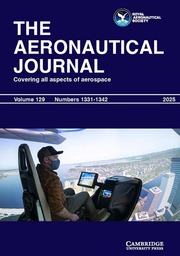Article contents
Experimental and numerical investigation of confined unsteady supersonic flow over cavities
Published online by Cambridge University Press: 12 October 2016
Abstract
Experimental investigations were carried out to study the acoustic radiation from a rectangular wall mounted cavity in a confined supersonic flow. The free-stream Mach number was maintained at 1·5 and the cavity length-to-depth ratio was varied from 0·43 to 5·0. Acoustic measurements made on the top wall show jumps in the dominant frequency as the cavity behaviour changes from shallow-to-square-to-deep cavity. Numerical simulations of this unsteady two-dimensional flow using the commercially available software FLUENT have also been carried out. Unsteady pressure data at the same location in the flow field as the pressure transducers in the experiments was collected. FFT analysis of the unsteady pressure data was performed to obtain the dominant acoustic frequencies. The values for these dominant frequencies predicted by the numerical calculations agree well with experimental data. The numerical study also predicts the frequency jump observed in experiments.
Information
- Type
- Research Article
- Information
- Copyright
- Copyright © Royal Aeronautical Society 2004
References
- 7
- Cited by

